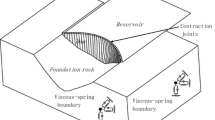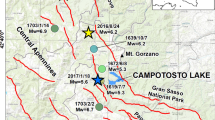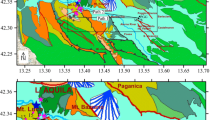Abstract
The seismic performance of geotechnical structures placed close to active faults is influenced by the peculiarities of the near-source seismic wave propagation. This issue is of paramount importance for large and massive structures, such as earth dams, for which the strong variability of the ground motion at the foundation level and the contribution of the vertical component of the motion could induce high differential settlements in the embankment with an increased risk for the structure. When modelling a structure in near-source conditions, the domain of analysis should be considerably wider than that typically adopted in the engineering field, since the seismic source and the propagation medium up to the reference site should be added to the structure and to the soil volume interacting with it. The paper illustrates the procedure developed to define the input motion at the Conza Dam site (Italy) during the 1980 Irpinia earthquake (November 23, 1980; Mw = 6.9). Due to the short distance of the site from the fault area, the Conza Dam is representative of several large dams placed in near-source areas in Italy and worldwide. The paper focuses on (1) the reconstruction of the regional structure of the Campania–Lucania region on the basis of former literature studies and on a new calibration of the 1D velocity model at regional scale; (2) the definition of the reference input motion at the site of Conza Dam with highlights on the spatial variability of the ground motion below the dam foundation and related effects on the structure.


























Similar content being viewed by others
References
Agip (1982) Aeromagnetic Survey of Italy. A few interpretative results. Agip Internal Report
Amato A, Selvaggi G (1993) Aftershock location and P-wave velocity structure in the epicentral region of the 1980 Irpinia earthquake. Ann Geophys 36(1):3–15
Ameri G, Emolo A, Pacor F, Gallovič F (2011) Ground-motion simulations for the 1980 M 6.9 Irpinia earthquake (Southern Italy) and scenario events. Bull Seismol Soc Am 101(3):1136–1151. doi:10.1785/0120100231
Amoruso A, Crescentini L, Fidani C (2004) Effects of crustal layering on source parameter inversion from coseismic geodetic data. Geophys J Int 159:353–364. doi:10.1111/j.1365-246X.2004.02389.x
Ascione A, Mazzoli S, Petrosino P, Valente E (2013) A decoupled kinematic model for active normai faults: insights from the 1980, Ms = 6.9 Irpinia earthquake, soutbem Italy. Geol Soc Am Bull 125(7–8):1239–1259
Bernard P, Zollo A (1989) The Irpinia (Italy) 1980 earthquake: detailed analysis of a complex normal fault. J Geophys Res 94:1631–1648
Bielak J, Loukakis K, Hisada Y, Yoshimura C (2003) Domain reduction method for three-dimensional earthquake modeling in localized regions. Part I: theory. Bull Seismol Soc Am 93:817–824
Bouchon M (2003) A review of the discrete wavenumber method, in Seismic Motion, Lithospheric Structures, Earthquake and Volcanic Sources: the Keiiti Aki Volume. Pageoph Topical Volumes 2003:445–465
Bouchon M, Aki K (1977) Discrete wavenumber representation of seismic source wave filed. Bull Seismol Soc Am 67:259–277
Casero P, Roure F, Vially L (1991) Tectonic framework and petroleum potential of the Southern Apennines, in generation, accumulation, and production of Europe’s hydrocarbon, European Association of petroleum geoscientists. In: Spencer AM (ed) Special publication, vol 1. Oxford University Press, Oxford, pp 381–387
Chiarabba C, Amato A (1994) From tomographic images to fault heterogeneities. Ann Geophys 37(6):1481–1494
Chiarabba C, Jovane L, Di Stefano R (2005) A new view of Italian seismicity using 20 years of instrumental recordings. Tectonophysics 395:251–268
Cinti FR, Faenza L, Marzocchi W, Montone P (2004) Probability map of the next M C 5.5 earthquakes in Italy. Geochem Geophys Geosyst 5:Q1103. doi:10.1029/2004GC000724
Cocco M, Pacor F (1993) The rupture process of the 1980 Irpinia, Italy, earthquake from the inversion of strong motion waveforms. Tectonophysics 218:157–177
Convertito V, De Matteis R, Cantore L, Zollo A, Iannaccone G, Caccavale M (2009) Rapid estimation of ground-shaking maps for seismic emergency management in the Campania Region of southern Italy. Springer, Berlin
Cotecchia V, Salvemini A, Ventrella NA (1990) Interpretazione degli abbassamenti territoriali indotti dal terremoto del 23 Novembre 1980 e correlazioni con i dati osservati su talune strutture ingegneristiche dell’area epicentrale irpina. Rivista Italiana di Geotecnica 4(1990):145–158 (in Italian)
Coutant O (1989) Program de simulation numerique AXITRA. In: Rapport LGIT. Universiteè Joseph Fourier, Grenoble
De Matteis R, Romeo A, Pasquale G, Iannaccone G, Zollo A (2010) 3D tomographic imaging of the southern Apennines (Italy): a statistical approach to estimate the model uncertainty and resolution. Stud Geophys Geod 54:367–387
De Matteis R, Matrullo E, Rivera L, Stabile TA, Pasquale G, Zollo A (2012) Fault delineation and regional stress direction from the analysis of background microseismicity in Southern Apennines, Italy. Bull Seismol Soc Am 102(4):1899–1907. doi:10.1785/0120110225
De Natale G, Martini M, Tersini E (1983). Il terremoto del 23 Novembre 1980: Spostamento su due faglie ortogonali collegato a movimiento di blocchi verticali. In: Paper presented at the 2nd Convegno Annuale, Gruppo Nas. di Geofis. della Terra Solida, Rome
Del Gaudio S (2014) Strong motion simulations with empirical Green functions: methodology and application to the 2009 L’Aquila earthquake. PhD Thesis, University of Naples, Federico II
Dello Russo A (2015) Seismic response of soil embankments in near-source conditions. PhD thesis, University of Naples Federico II
DISS Working Group (2010) Database of Individual Seismogenic Sources (DISS), Version 3.1.1: A compilation of potential sources for earthquakes larger than M 5.5 in Italy and surrounding areas. http://diss.rm.ingv.it/diss./INGV. Last accessed June 2012
Frepoli A, Amato A (2000) Spatial variation in stress in peninsular Italy and Sicily from background seismicity. Tectonophysics 317:109–124
Graves R, Pitarka A (2016) Kinematic ground motion simulations on rough faults including effects of 3D stochastic velocity perturbations. Bull Seismol Soc Am 106:2136–2153
Iannaccone G, Improta L, Capuano P, Zollo A, Biella G, De Franco R, Deschamps A, Cocco M, Mirabile L, Romeo R (1998) A P-wave velocity model of the upper crust of Sannio region (Southern Apennines), Italy. Ann Geophys 41(4):567–582
Improta L, Iannaccone G, Capuano P, Zollo A, Scandone P (2000) Inferences on the upper crustal structure of Southern Apennines (Italy) from seismic refraction investigations and subsurface data. Tectonophysics 317:273–297
Improta L, Zollo A, Herrero A, Frattini R, Virieux J, Dell’Aversana P (2002) Seismic imaging of complex structures by non-linear traveltime inversion of dense wide-angle data: application to a thrust belt. Geophys J Int 151:264–278
Improta L, Bonagura M, Capuano P, Iannaccone G (2003) An integrated geophysical investigation of the upper crust in the epicentral area of the 1980, Ms = 6:9, Irpinia earthquake (Southern Italy). Tectonophysics 361(1–2):139–169
Lancieri M, Zollo A (2009) Simulated shaking maps for the 1980 Irpinia earthquake, Ms 6.9: insightson the observed damage distribution. Soil Dyn Sand Earthq Eng 29:1208–1219
Maggi C, Frepoli A, Cimini GB, Console R, Chiappini M (2009) Recent seismicity and crustal stress field in the Lucanian Apennines and surroundings areas (Southern Italy): seismotectonic implications. Tectonophysics 463:130–144
Malagnini L, Hermann RB, Di Bona M (2000) Ground-motion scaling in the Apennines (Italy). Bull Seismol Soc Am 90(4):1062–1081
Matrullo E, De Matteis R, Satriano C, Amoroso O, Zollo A (2013) An improved 1-D seismic velocity model for seismological studies in the Campania–Lucania region (Southern Italy). Geophys J Int 195:460–473
Menardi A, Rea G (2000) Deep structure of the Campania–Lucania arc (Southern Apennine, Italy). Tectonophysics 324:239–265
Montone P, Mariucci MT, Pondrelli S, Amato A (2004) An improved stress map for Italy and surrounding regions (central Mediterranean). J Geophys Res 88:6415–6429
Mostardini F, Merlini S (1986) Appennino centro-meridionale. Sezioni geologiche e proposta di modello strutturale. Mem Soc Geol Ital 35:177–202 (in Italian)
Pantosti D, Valensise G (1990) Faulting mechanism and complexity of the 23 November 1980, Campania–Lucania earthquake, inferred from surface observations. J Geophys Res 95:15319–15341
Pantosti D, Valensise G (1993) Source geometry and long-term behavior of the 1980, Irpinia earthquake fault based on field geologic observations. Ann Geophys 36(1):41–499
Panza GF, Duda SJ, Cernobori L, Herak M (1989) Gutenberg’s surface-wave magnitude calibrating function: theoretical basis from synthetic seismograms. Tectonophysics 166:35–43
Pasquale G, De Matteis R, Romeo A, Maresca R (2009) Earthquake focal mechanisms and stressinversion in the Irpinia Region (southern Italy). J. Seismol. 13:107–124. doi:10.1007/s10950-008-9119-x
Patacca E, Scandone P (1989) Post-Tortonian mountain building in the Apennines: the role of the passive sinking of a relic lithospheric slab. In: Boriani A (ed) The lithosphere in Italy: advances in earth science research, vol 80. Accademia Nazionale dei, Rome, pp 157–176
Patacca E, Scandone P (2001) Late thrust propagation and sedimentary response in the thrust–belt–foredeep system of the southern Apennines (Pliocene–Pleistocene). In: Vai GB, Martini IP (eds) Anatomy of an Orogen: the Apennines and the Adjacent Mediterranean Basins. Kluwer Academic Publishers, pp 401–440
Roure F, Casero P, Vially R (1991) Growth processes and melange formation in the Southern Apennines accretionary wedge. Earth Planet. Sci. Lett. 102:395–412
Scandella L (2007) Numerical eavaluation of transient ground strains for the seismic analysis of underground structures. PhD Thesis. Politecnico di Milano
Scrocca D, Carminati E, Doglioni C (2005) Deep structure of the southern Apennines, Italy: thin-skinned or thick-skinned? Tectonics 24:1–20
Somerville PG (2005) Engineering characterization of near fault ground motion.In: New Zealand society for earthquake engineering conference (NZSEE), 2005, Taupo, New Zealand, p 8
Valensise G, Pantosti D (2001) Seismogenic faulting, moment release patterns and seismic hazard along the central and southern Apennines and the Calabrian. Arc. In: Vai GB, Martini IP (eds) Anatomy of an orogen: the Apennines and adjacent Mediterranean basins. Kluwer, Dordrecht, pp 495–512
Valensise G, Basili R, Mucciarelli M, Pantosti D (2002) Database of Potential Sources for Earthquakes Larger than M 5.5 in Europe. A compilation of data collected by partners of the EU project FAUST. Distributed through the Internet. http://www.ingv.it/~roma/banche/catalogo_europeo
Vilardo G, Nappi R, Petti P, Ventura G (2003) Fault geometries from the space distribution of the 1990–1997 Sannio–Benevento earthquakes: inferences on the active deformation in Southern Apennines. Tectonophysics 363:259–271
Wells DL, Coppersmith KJ (1994) New empirical relationships among magnitude, rupture length, rupture width, rupture area, and surface displacement. Bull Seismol Soc Am 84(4):974–1002
Westaway RWC, Jackson J (1984) Surface faulting In the southern Italian Campania-Basilitica earthquake of 23 November 1980. Nature 312:436–438
Westaway R, Jackson J (1987) The earthquake of 1980 November 23 in Campania–Basilicata (Southern Italy). Geophys J R Astr Soc 90:375–443
Yoshimura C, Bielak J, Hisada Y, Fernandez A (2003) Domain reduction method for three-dimensional earthquake modeling in localized regions. Bull Seism Soc Am 93:825–840
Zollo A, Orefice A, Convertito V (2014) Source parameter scaling and radiation efficiency of microearthquakes along the Irpinia fault zone in southern Apennines, Italy. J Geophys Res Solid Earth 119:3256–3275
Acknowledgements
The research programme was carried out as part of WorkPackage 2 (WP2—Earth Dams) of the Geotechnical Research Line included in the research activity funded by Italian Civil Protection through the ReLUIS (University Network of Seismic Engineering Laboratories) Consortium. Prof. S. Rampello, coordinator of the WP2, is gratefully acknowledged. The authors wish to thank also Prof. F.M. Guadagno and P. Revellino of the University of Sannio for the FLAC3D license and Prof. Luca Pagano for the interpretation of the monitoring data on Conza Dam.
Author information
Authors and Affiliations
Corresponding author
Appendix
Appendix
1.1 Domain reduction method
The main advantage of the domain reduction method (DRM) is the possibility of substructuring the original problem (Fig. 27a) into two numerical sub-models characterized by different scale dimensions and solved in two different steps (Fig. 27b–c). The methodology is illustrated in Bielak et al. (2003) and Yoshimura et al. (2003) for 3D problems of increasing physical and computational complexity. Referring to the above references for details on the method, only the main features will be here illustrated.
Real seismic region. a Scheme of the semi-infinite seismic region, including the causative fault, geological structure and local features. b Outer boundary \(\varGamma^{ + }\) restricts computation to a finite domain; fictitious interface \(\varGamma\) divides region into two subdomains: \(\varOmega^{ + }\) which includes the seismic source, represented by nodal forces P e and \(\varOmega\) containing the geological features in the domain of interest. c Scheme of the region partitioned in two subdomains across the interface \(\varGamma\) where P b are the nodal forces transmitted by \(\varOmega^{ + }\) into \(\varOmega\) (Bielak et al. 2003)
Step 1 The first model, which may span thousands of meters (Fig. 27b), is an auxiliary one and represents a simplification of the real external domain. In this step the earthquake source and propagation path are simulated. As proposed by Bielak et al. (2003), a stratigraphic system (flat-layer scheme), solved by means of 3D Green function, is simulated.
Step 2 The second model (Fig. 27c) contains the domain of interest with reduced spatial dimensions (internal domain), including the structure and the surrounding soil. The seismic source and most of the propagation path from the source to the site are now excluded. The input is given as a set of equivalent nodal forces applied to the interface elements and able to reproduce the seismic source modelled in the first step.
The interaction forces (either contact or boundary forces), P b , are localized on the fictitious surface \(\varGamma\), which divides the entire domain in the two regions \(\varOmega\) and \(\varOmega^{ + }\), containing respectively the geological features of interest and the semi-infinite exterior subdomain, which includes the fault (Fig. 27b). The vector field of nodal displacements defined ithe interior domain \(\varOmega\) the exterior domain \(\varOmega^{ + }\) and the boundary between them, \(\varGamma\), will be denoted by u i (interior), u e (exterior) and u b (boundary), respectively. In the same figure \(\varGamma^{ + }\) is the outer boundary that truncates the original semi-infinite region and where the absorbing boundary conditions are applied.
Rights and permissions
About this article
Cite this article
Dello Russo, A., Sica, S., Del Gaudio, S. et al. Near-source effects on the ground motion occurred at the Conza Dam site (Italy) during the 1980 Irpinia earthquake. Bull Earthquake Eng 15, 4009–4037 (2017). https://doi.org/10.1007/s10518-017-0138-2
Received:
Accepted:
Published:
Issue Date:
DOI: https://doi.org/10.1007/s10518-017-0138-2





